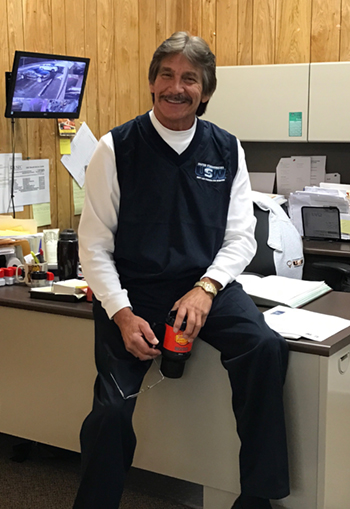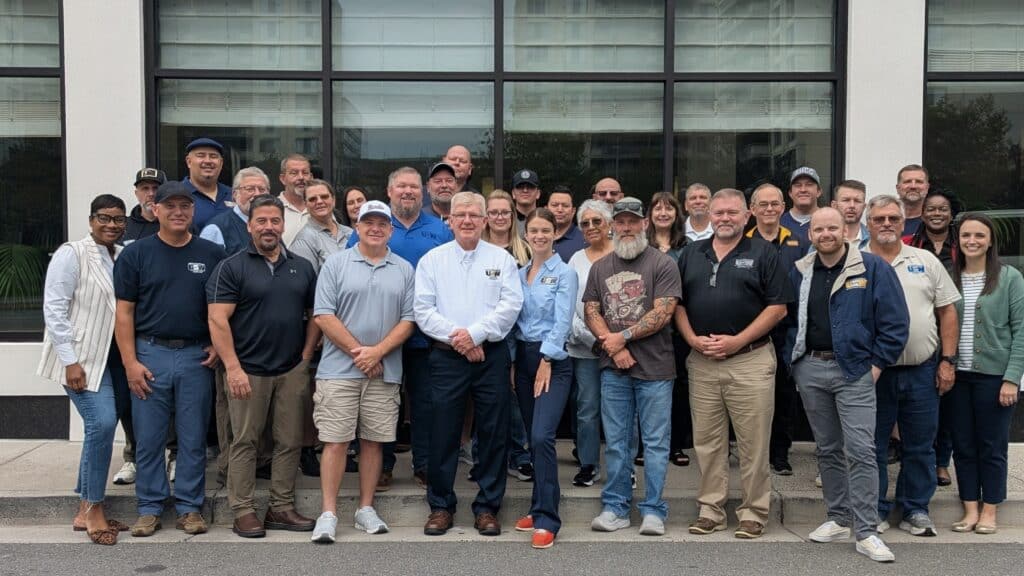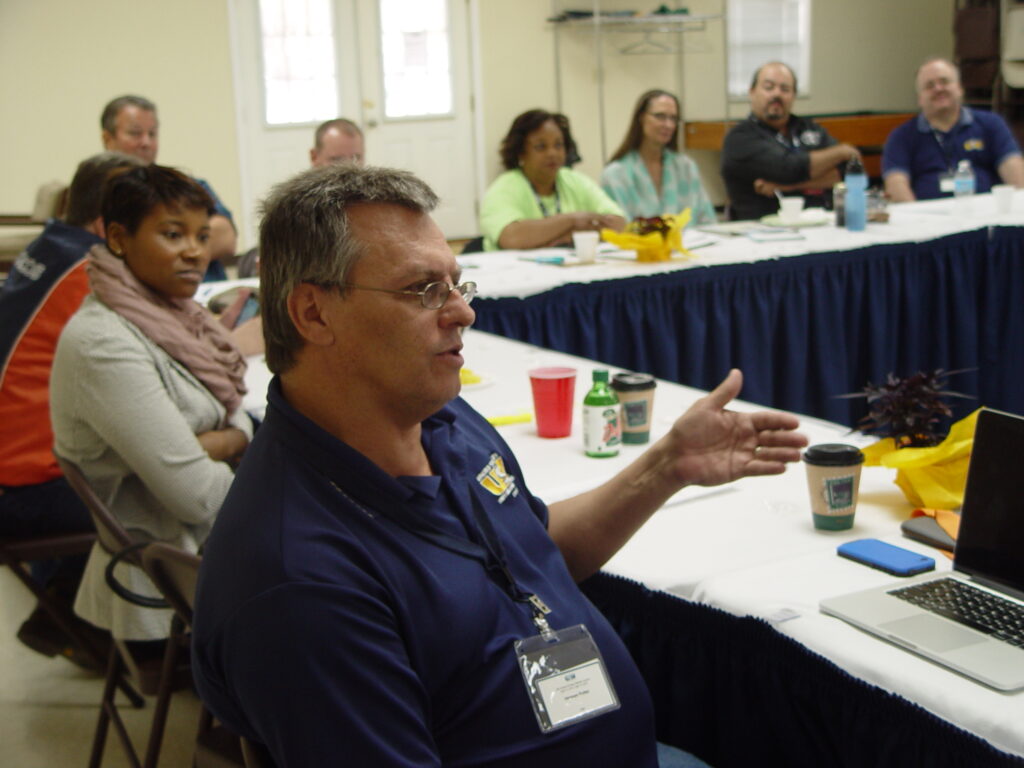Nuclear Worker Compensation Program Turns 20
 The Energy Employees Occupational Illness Compensation Program Act (EEOICPA), which provides compensation and medical care to qualified nuclear workers, turned 20 this past fall, and nuclear workers can thank Local 550 Vice President At-large Jim Key for his role in getting legislative relief for sick nuclear workers.
The Energy Employees Occupational Illness Compensation Program Act (EEOICPA), which provides compensation and medical care to qualified nuclear workers, turned 20 this past fall, and nuclear workers can thank Local 550 Vice President At-large Jim Key for his role in getting legislative relief for sick nuclear workers.
In September 1999, Jim Key testified before the first House Oversight and Investigative subcommittee on nuclear worker exposure when he was Local 550’s health and safety representative.
Workers, the Paducah community, elected officials and the general public became aware of radioactive plutonium, neptunium and technetium contamination at the former Paducah Gaseous Diffusion Plant after The Washington Post published a ground-breaking, front-page exposé on Sunday, Aug. 8, 1999.
Three plant employees filed a lawsuit against the federal government and plant contractors alleging radiation exposure. Key said their lawyers knew the Post reporter, Joby Warrick, and gave him documents from the lawsuit.
By 2 p.m. on Aug.8, 1999, Key, the local union president, Department of Energy (DOE) and contractor representatives and the area’s congressional representative toured the plant in a bus.
The Post investigation revealed that from 1953 to 1976, DOE shipped to Paducah crushed, spent fuel rods from nuclear reactors at Hanford and Savannah River that made plutonium for bombs.
Key said the material arrived in containers on freight cars and semi-trucks as crushed black gravel. This material contained leftover, highly radioactive material from the fission process in the reactors—byproducts like technetium-99, neptunium, plutonium and even leftover uranium.
Workers pulverized the gravel-like material into a fine powder in the C-410 Feed Materials building, Key said, and converted it into uranium hexafluoride for use in the uranium enrichment process.
Risk not revealed
The plant’s contractors from 1952 on, the Atomic Energy Commission (DOE’s predecessor agency) and the Department of Energy (DOE) were aware of this highly radioactive material being used, but believed the amount was too small to be a health concern.
They never told workers about the radioactive material they were handling and the risks of exposure they faced.
“We were told that the uranium substances we were working with were safe and posed no threat to our health or to the health of our families. We were told we were not getting any dose. We were even told that materials were safe enough to eat,” said plant worker Garland (Bud) E. Jenkins in testimony before a House subcommittee in September 1999.
Key testified at the same hearing that although the union requested it, no medical monitoring had been done at the site. He said that DOE contractors did not start requiring bioassay samples from workers to determine if they ingested plutonium, neptunium and other transuranics until 1991, and the results were not reported to workers. He said the contractor informed the workers that their bioassay samples had resulted in cross contamination in the lab processing the samples, and therefore all samples were invalidated.
Former workers also alleged that radiation monitoring equipment at the Paducah plant was defective or too archaic to monitor for certain radiological isotopes, and that film badges workers wore to monitor radioactive exposure sometimes contained no film.
Health physicist Ronald B. Fowler—one of the lawsuit plaintiffs—testified before the same House subcommittee that when he came to Paducah in 1991, the facility essentially did not have a health physics program to protect workers and the public from excessive and unnecessary exposure to radiation.
Fowler and Key researched plant documents. Information Key obtained through Freedom of Information Act (FOIA) requests revealed that in the C-410 building, workers also separated the plutonium from the recycled uranium fuel for use in future nuclear warheads.
Key said he gave some of the documents to the local’s president, and copied them for a friend to lock up in his office.
“I told him if I suddenly die, to go to the national press with this,” Key said. “If Karen Silkwood could be killed, I thought I could be, too.”
Silkwood was the famed nuclear worker activist who mysteriously died while driving to meet a New York Times reporter with evidence of safety violations and negligence at the Kerr-McGee Cimarron River nuclear facility where she worked as a lab technician.
Compensation & medical care needed
Key testified that nuclear workers at Paducah and other DOE sites needed more than medical monitoring. They also should receive workers compensation and health insurance coverage for themselves and their spouses through retirement.
Whenever sick nuclear workers attempted to file for state workers’ compensation, DOE and the contractors fought them every step of the process, and spent millions of dollars denying them compensation.
After testifying before the House subcommittee, Key spent the next nine weeks meeting with every representative and senator to urge passage of a proposed Energy Employees Occupational Illness Compensation Program Act (EEOICPA).
He said EEOICPA passed both houses of Congress on consent, meaning there was not a single vote cast in opposition to the legislation. President Clinton signed the bill into law on October 30, 2000.
Part B of EEOICPA became effective on July 31, 2001. It offered compensation to current and former atomic workers or their survivors. Workers diagnosed with radiation-induced cancer, beryllium disease or silicosis who had worked in America’s bomb-making factories could receive a lump-sum payment of $150,000 and medical benefits for the covered illness.
Congress enacted Part E of EEOICPA on Oct. 28, 2004 and it provided compensation for nuclear workers exposed to any toxic substance. Claimants with approved claims can receive payment for lost wages and impairment of up to $250,000 plus medical benefits for the covered illness.
Pictured: Jim Key
By clicking Sign Up you're confirming that you agree with our Terms and Conditions.
Recent News Articles
Want to Learn More?
See how the USW is making a real difference in our communities and our workplaces.

